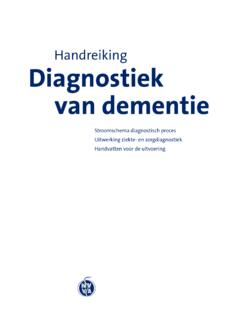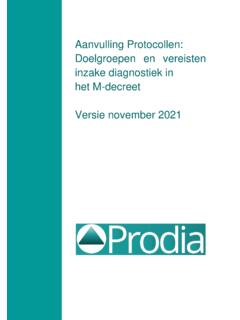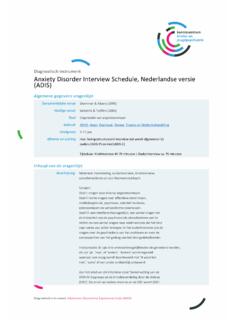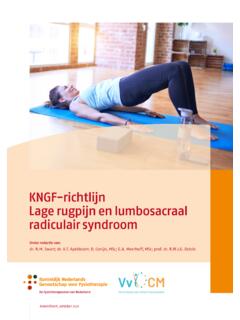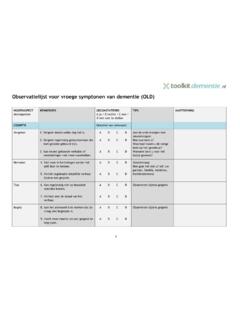Transcription of APRAXIA TEST
1 APRAXIA TEST. Caroline van Heugten and Chantal Geusgens Purpose The APRAXIA test is meant as a screeningtest to measure the presence and severity of APRAXIA (ideational, ideomotor). Test description The test consists of 2 subtests: demonstration of object use and imitation of gestures. Demonstration of object use is targeting ideational APRAXIA , while imitation of gestures is directed at assessing ideomotor APRAXIA . In total 9 objects are presented (3 verbal command, 3 verbal and visual command, 3 actual object use) and 6 gestures are imitated. The performance of the patient is scored on a scale ranging from 0 to 90. The test is reliable and valid and has been used in stroke and healthy populations. Testing Age The APRAXIA test is for adult patients; there is no upper age limit for elderly patients. Material The APRAXIA test consists of 2 subtests: demonstration of object use and imitation of gestures. The following daily objects are needed for testing: - spoon, hammer en scissors (demonstration pantomime).
2 - eraser, comb and screwdriver (actual object use). - candle (imitation). Testprocedure and instructions The tasks are being performed with the healthy hand (of the non-impaired bodyside). to reduce the effect of motor or sensory deficits. In case there are no motor or sensory deficits, the patient can perform with the dominant hand. The test materials and objects should be assembled by the examiner before starting the test. The objects should not be visible for the patient. The patient gets a first trial. When the performance is correct, the score of 6 is given and the next item can be offered. In case the performance is not completely correct, the patient gets a second trial (repetition) and the scores of both trials are added. Patients with aphasia should be offered the test because the items are fairly simple in terms of verbal effort. However, in case the aphasia interferers with understanding the 1. instructions, the test should not be scored.
3 In those instances a qualitative observation of the patients performance can be given for clinical purposes. The APRAXIA test can only be used by persons with experience in neuropsychological testing. The APRAXIA test adds up to 1 score ranging from 0 to 90. For both subtests a subscore is calculated. In addition, a qualitative description can be given on the basis of observing the patient. The APRAXIA test ttakes about 10 minutes to administer. Scoring 6= the performance of the first trial is correct and appropriate for the object or gesture 3= the performance of the second trial is correct and appropriate for the object or gesture 2= the performance resembles the correct response, but is clumsy, slow, of performed with errors or the patient used a bodypart as object 1= the performance only slightly resembles the correct response and is performed at the correct place or the performance is correct but performed at the wrong place 0= the performance is incorrect or does not resemble the correct response In case trial 1 is not completely correct, feedback can be given to guide trial 2.
4 In case of perseveration: - Within the same item: say ok, fine'. In case the patient does not stop, the examiner can tell the patient to stop. A score of 2 is given. Across item: the score 0 is given. Cut-off value A cut-off val;ue of 86 is recommended. A higher score than 86 means no presence of APRAXIA . Literature De Renzi E (1989). APRAXIA . In J. G. F. Boller (Ed.), Handbook of Neuropsychology (Vol. 2, pp. 245-263). Amsterdam: Elseviers Science Publishers Donkervoort M (2002). APRAXIA following left hemisphere stroke: prevalence, assessment and rehabilitation. Dissetatie, Vrije Universiteit Amsterdam Heugten CM van (1998). APRAXIA in stroke patients: assessment and treatment. Dissertatie, Rijksuniversiteit Groningen Heugten CM van, Geusgens C (2004). Handleiding apraxie test. Hoensbroek: iRv. 2. Heugten CM van, Dekker J, Deelman BG, Stehmann-Saris JC, & Kinebanian A. (1999). A diagnostic test for APRAXIA in stroke patients: internal consistency and diagnostic value.
5 The Clinical Neuropsychologist, 13(2), 182-192. Heugten CM van, Dekker J, Deelman BG, Dijk AJ van, Stehmann-Saris JC, Kinebanian A. Measuring disabilities in stroke patients with APRAXIA : a validation study of an observational method. Neuropsychological Rehabilitation 2000; 10 (4): 401-14. Heugten CM van. Rehabilitation and management of APRAXIA after stroke. Reviews in clinical gerontology 2001; 11: 177-184. Stehmann-Saris JC, Satink AJH, Daniels R, Berendsen B, Boerma M, Janssen J, Broekman JB, de Graaf M, Jonges A, & Vet R (2003a). Ergotherapie richtlijn voor diagnostiek en behandeling van apraxie bij CVA-clienten. Amsterdam: Hogeschool van Amsterdam Stehmann-Saris JC, Satink AJH, Daniels R, Berendsen B, Boerma M, Janssen J, Broekman JB, de Graaf M, Jonges A, & Vet R (2003b). Werkboek ergotherapie richtlijn voor diagnostiek en behandeling van apraxie bij CVA-clienten. Amsterdam: Hogeschool van Amsterdam Zwinkels A, Geusgens C, van de Sande P, & Heugten C van (2004).
6 Assessment of apraxie: Inter-rater reliability of a new APRAXIA test, association between APRAXIA and other cognitive deficits and prevalence of APRAXIA in a rehabilitation setting. Clinical Rehabilitation, 18(7), 819-827. 3. Instructions APRAXIA test Instructions: 1. Demonstratiof object use The patient is asked to pantomime the use of an object. A. Pantomime 1. No object present; ask: Can you show me how you would use a pen (key, saw, toothbrush)? . Or Can you act as if you use a pen? . The pen is an example and will not be taken into account in the scoring. The patients will be corrected in case of errors or problems in understanding the instruction. The toothbrush is a normal toothbrush, not an electronic version or dentures. The movement of the hand should be made in front of the mouth while the mouth is open. Fingers can not be used as toothbrush. B. Pantomime 2. The objects are placed in front of the patient, but cannot be touched.
7 Ask: Can you show me how you would use (name object)? You are not allowed to touch the object.. C. Actual object use The objects are placed in front of the paient. The patient is invited to actually use without the name of tje object mentioned. Do not place the object in the hand of the patient. Ask: Can you show me how you would use this object? You can take it in your hand.. 2. Imitation of gestures The gestures are demonstrated as mirror image. And the patient is invited to imitate the examiner. Ask: I will show you a gesture, can you imitate me? . The candle is placed in front of the mouth and is blown down. Closing the eyes should be done explicitely. Saluting is done with the palm of the hand to the front and the thumb case the patient has an automatic saluting response which is different, score 2 and give a second trial saying can you do exactly as I do? . Making a fist should not be understood as an aggressive expression towards the patient.
8 4. Score form APRAXIA test 1. Demonstration object use A. Pantomime 1. No object present; ask: Can you show me how you would use a pen (key, saw, toothbrush)? . Or Can you act as if you use a pen? . Example: 0. pen (no scoring, correction if necessary). Trial 1 Trial 2. Score 1. key 6 2 1 0 3 2 1 0 . 2. saw 6 2 1 0 3 2 1 0 . 3. toothbrush 6 2 1 0 3 2 1 0 . B. Pantomime 2. The objects are placed in front of the patient, but cannot be touched. Ask: Can you show me how you would use (name object)? You are not allowed to touch the object.. Trial 1 Trial 2. Score 4. spoon 6 2 1 0 3 2 1 0 . 5. hammer 6 2 1 0 3 2 1 0 . 6. scissors 6 2 1 0 3 2 1 0 . C. Actual object use The objects are placed in front of the paient. The patient is invited to actually use without the name of the object mentioned. Do not place the object in the hand of the patient. Ask: Can you show me how you would use this object? You can take it in your hand.. Trial 1 Trial 2.
9 Score 7. eraser 6 2 1 0 3 2 1 0 . 8. comb 6 2 1 0 3 2 1 0 . 9. screwdriver 6 2 1 0 3 2 1 0 . Demonstration score: . 5. 2. Imitation of gestures The gestures are demonstrated as mirror image. And the patient is invited to imitate the examiner. Ask: I will show you a gesture, can you imitate me? . Trial 1 Trial 2. Score 1. blowing out candle 6 2 1 0 3 2 1 0 . 2. shutting the eyes 6 2 1 0 3 2 1 0 . 3. waving goodbye 6 2 1 0 3 2 1 0 . 4. sticking out tongue 6 2 1 0 3 2 1 0 . 5. saluting 6 2 1 0 3 2 1 0 . 6. making a fist 6 2 1 0 3 2 1 0 . Imitation score: . Totals core: . Remarks: 6.
